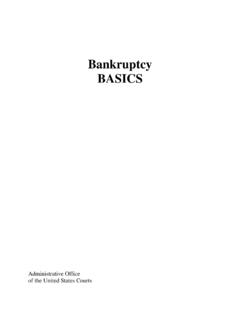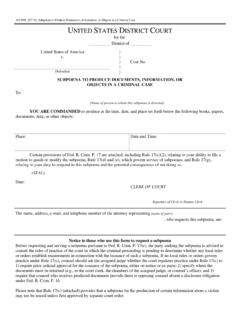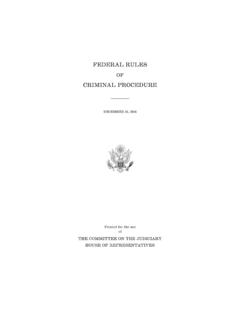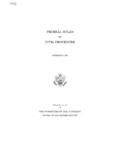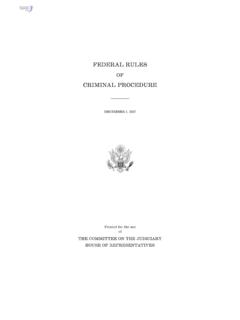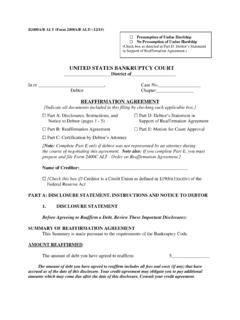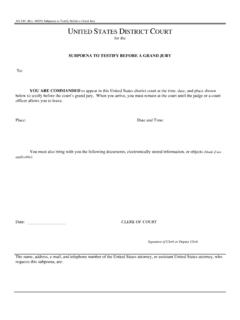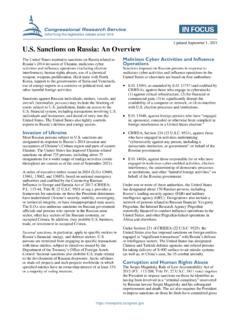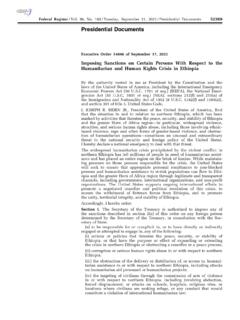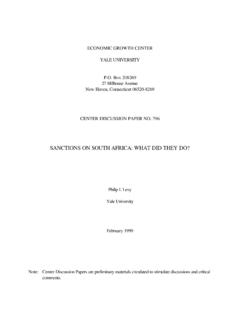Transcription of Motions for Sanctions Based Upon Spoliation of Evidence in ...
1 Motions for Sanctions Based Upon Spoliation of Evidence in Civil Cases Report to the Judicial Conference Advisory Committee on Civil Rules Emery G. Lee III Federal Judicial Center 2011 This Federal Judicial Center publication was undertaken in furtherance of the Center s statutory mis-s ion to conduct and s timul ate res earch and dev el opment for the improv ement of j udicial adminis tra-tion. While the Center regards the content as responsible and valuable, it does not reflect policy or recommendations of the Board of the Federal Judicial C enter. Mot ion s for San ct ion s Based Upon Spoliat ion of Eviden ce in C ivil C ases F ederal Ju dicial C en t er 2011 1 Executive Summary In 2010, the Judicial Conference Advisory Committee on Civil Rules requested a study of Motions for Sanctions Based on an allegation that the nonmoving party had destroyed Evidence , especially electronically stored information (ESI).
2 The study examined the electronic docket records of civil cases filed in 2007 2008 in 19 districts, including at least one district in every circuit except the District of Co-lumbia Circuit. This report summarizes the f in din gs of that study an d, where appropriate, compares those findings to other studies. The study found the following: A motion related to Spoliation of Evidence was identified in 209 total cases in the 19 districts, which was of civil cases filed in the study districts in 2007 2008. The allegedly spoliated Evidence included ESI in 53% of these 209 cases. It was exclusively ESI in 40%. In 9% of cases, the nature of the spoliated evi-dence could not be determined. For all Spoliation Motions , the most common nature-of-suit categories were torts (31%), contracts (30%), and civil rights (22%).
3 For Spoliation Motions involving ESI, the most common nature-of-suit categories were con tracts (36%), civil rights (26%), torts (14%), an d in tel-lectual property (11%). The moving party was a plaintiff in 64% of the cases and a defendant in 32%. Both sides moved for Sanctions Based on Spoliation in 2% of cases. The typical plaintiff moving for Sanctions was an individual, but in 31% of cases the plaintiff movant was a business entity. Plaintiffs generally filed Motions for Sanctions against business entities (74%) or a government (21%). The typical defendant moving for Sanctions was a business entity, account-ing for almost 90% of defendant movant cases. Defendants generally filed Sanctions Motions against individuals, but in 41% of defendant movant cases the nonmoving party was a business en-tity.
4 Motions for Sanctions were granted in 18% of all cases and denied in 44% of all cases. Considering only cases with an order on the motion, Motions were granted 28% of the time and denied 72% of the time. Mot ion s for San ct ion s Based Upon Spoliat ion of Eviden ce in C ivil C ases F ederal Ju dicial C en t er 2011 2 In ESI cases, Motions for Sanctions were granted 23% of the time and de-nied 44% of the time. Considering only cases with an order on the motion, Motions were granted 34% of the time and denied 66% of the time. The most common type of sanction granted was an adverse inference jury instruction, which was granted in 44% of all cases in which a sanction was imposed and in 57% of comparable ESI cases.
5 A dismissal or default judg-ment was only imposed in one case, which involved tangible Evidence . Mot ion s for San ct ion s Based Upon Spoliat ion of Eviden ce in C ivil C ases F ederal Ju dicial C en t er 2011 3 Findings At the request of the Honorable Mark R. Kravitz, then chair of the Judicial Confer-ence s Advisory Committee on Civil Rules ( Committee ), the Federal Judicial Center (FJC) conducted a study of Motions filed in federal court alleging Spoliation of Evidence in civil cases. This report summarizes the findings of that study. The report consists of three parts. The first part attempts to answer the threshold ques-tion, how often is Spoliation raised by motion? The second part describes the cases in which Spoliation is alleged.
6 The third part provides some information on how courts rule on Motions for Sanctions . How often is Spoliation raised? The threshold question is, how often is Spoliation raised by motion? The text- Based search of the CM/ECF database employed in this study identified every case in the study districts filed in either 2007 or 2008 and in which the search terms1 appeared in a docket entry. Clearly, this search cannot identify every motion for Sanctions Based on an allegation of Spoliation , but I am generally satisfied that the search found most of these I personally reviewed the docket records in every case in which the search terms appeared. After that review, I determined that the issue of Spoliation had been raised in a motion (of some type) in 209 cases in the 19 study In 153 of those cases, the issue was raised in a motion for Sanctions .
7 In 29 cases, the issue was raised in a pretrial motion in limine. In 23 cases, the issue was raised in a motion related to jury instructions. And in four cases, the issue was raised in a motion for summary judgment. 1. The rel ev ant s earch terms were s pol iation, s poil ation, 37(e), 37e, adv ers e inference, violation and preservation in same docket entry, and destruction of Evidence . My FJC colleague George Cort performed the searches of the relevant databases. 2. In a few districts, an alternate search strategy, using other information in the database identify-ing Sanctions Motions , was employed to validate the text- Based search. The results of the alternate strategy suggested that the text- Based search was not missing many cases.
8 Moreover, the text- Based search almost certainly identified cases that the alternate strategy would have missed, such as cases in which the Spoliation issue was raised in a motion in limine. The search for Sanctions Motions was inefficient, in that it identified all Sanctions Motions , regardless of basis including Federal Rule of Civil Procedure 11 Motions , which are unrelated to Evidence , and all Motions for discovery sanc-tions, not limited to those Based on Spoliation . 3. The 19 study districts were Northern District of California, Colorado, Southern District of Florida, Northern District of Georgia, Northern District of Illinois, Northern District of Iowa, East-ern District of Louisiana, Massachusetts, Maryland, Minnesota, New Jersey, Eastern District of New York, Southern District of New York, Northern District of Ohio, Southern District of Ohio, Western District of Oklahoma, Eastern District of Pennsylvania, Southern District of Texas, and Western Dis-trict of Wisconsin.
9 Mot ion s for San ct ion s Based Upon Spoliat ion of Eviden ce in C ivil C ases F ederal Ju dicial C en t er 2011 4 To determine the rate at which Spoliation is raised by motion, the most direct method is to treat these 209 cases as the numerator and to treat the total number of (comparable) civil cases filed in the study districts in 2007 2008 as the denomi-nator. The latter figure is 131,992 cases,4 yielding a rate of In other words, a motion alleging Spoliation was found in of cases filed in 2007 2008 in the study districts. This estimate compares favorably to other studies. I am not aware of any study that indicates that such Motions are relatively common. An Institute for the Ad-vancement of the American Legal System (IAALS) study of case processing in eight districts found that Motions for discovery Sanctions , not limited to Spoliation mo-tions, were filed in of The present study s estimate is approximately 5% of that figure, which probably reflects that Spoliation Motions are not a very common form of Sanctions motion.
10 A study of published orders, prepared for the Civil Litigation Review Conference by Willoughby, Jones, and Antine ( Willoughby study ), found 401 total ESI cases in which Sanctions were moved for in federal court, without time The Willoughby study identified approximately 170 ESI cases with a Sanctions motion in all federal districts in 2008 That estimate is not limited to Spoliation Motions . The Willoughby study identified only 136 cases over an almost 30-year period in which Sanctions were granted for de-struction of One other previous study warrants mention. The 2009 FJC closed-case survey asked attorneys in cases involving ESI whether any party raised a claim of spolia-tion of ESI.
